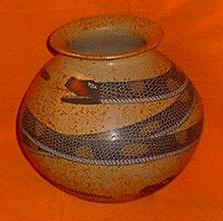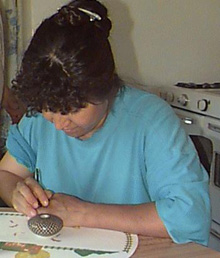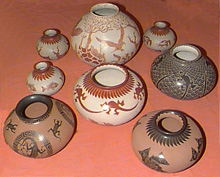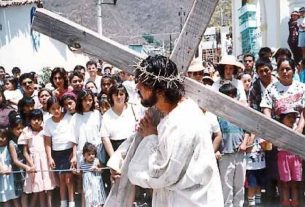Juan Mata Ortíz is a small village of potters, farmers and cowboys in Northern Chihuahua. About 30 years ago, an unschooled artistic genius, Juan Quezada, taught himself how to make earthenware jars in a method used hundreds of years ago by the prehistoric inhabitants. Now, his works are known worldwide and over 300 men, women and children in the village of less than 2000 make decorative wares. Much of the polychrome and blackware is feather light and exquisitely painted.
Many of the potters are also cowboys and farmers. These stories serve to document the art and the people in this unassuming pueblo, which is often called “magical” by the relative handful of tourists who visit. Enjoy this other view of Mexico–Michael Williams.
“Once, we were so poor, before we began making pottery,” Angela Bañuelos said to me as we sat with her husband, Roberto, in their spanking new living room sipping Nescafe. “Now things are much better, for us and our children.”
As the pottery of Juan Quezada has become more well-known throughout North America, Europe and Japan, more and more residents of Mata Ortíz have elected to give up their other jobs to learn to make earthenware. Men who were ranchers or laborers in the fields of others and women who were full-time housewives are eagerly reaching for the brass ring of the collectors’ dollar. Here are brief stories of three such families:
Roberto & Angela Bañuelos
These two are always smiling. When I first met them in 1989, they lived in a humble three-roomed adobe house with crumbling walls and a sagging earthen ceiling. But they greeted me warmly at the door and displayed five wonderful Mimbres replica plates on their double bed. (Mimbres were a Pre-Columbian group which lived in the Southwest about 800 years ago). Astonished at the beauty of the black animal designs on whiteware, my friend and I bought them all at $20.00 apiece.

Two years earlier, Roberto was a laborer in the fields of nearby Colónia Juarez. He worked 48 hours a six-day week for about $21.00. Angela struggled at home to make ends meet and feed herself, her husband and two young children aged four and two.
Her aunt was a pottery student of Reynalda Quezada, who in turn had learned the craft from her brother, Juan, the master. “We decided that Roberto would quit working in the fields and we would both learn how to become potters,” Angela said. It was a great risk, Roberto acknowledged, for there would be even less money coming in for some time.
Roberto had always enjoyed art and still saved his grade school notebook (he went through the sixth grade) which seemed to contain more of his pencilled cartoon characters than math problems. Making the pots was difficult for him, but the painting was a natural. Fortunately, Angela was adept at fashioning the clay bowls and jars.
Soon, Roberto was selling simple, painted blackware in Nuevo Casas Grandes for a few pesos each. One day while selling some bowls he met an archaeologist from New Mexico. The scholar had heard of the Mata Ortíz phenomenon and was looking for someone to make signed replicas of the pre-Columbian Mimbres plates. His goal was to slow the illegal trafficking in the ancient wares.
Equipped with some coaching and a book of the Mimbres designs, Roberto was soon churning out the plates – and he developed a unique niche in the local cottage industry. It was a turning point for the pottery team. With more recognition from the plates, more visitors came to also purchase the black and polychrome pots, or ” ollas,” that his wife fashioned and he painted.
By the early 90s, Roberto and Angela were ready to begin home improvements.
“What do you really want first?” I wondered.
“Indoor plumbing,” they replied in unison.
As their house grew, so did Angela’s ability to make thinner, uniformly symmetrical pots and Roberto’s skill as a painter and innovator. The two of them are in high demand and Roberto makes few plates. Now, large yellow ollas, flecked with red paint to create a golden hue, are adorned with rattlesnakes sweeping around the jars, fluttering butterflies or scrambling iguanas. Always experimenting, the two are continually creating new forms and designs.
Recently, they purchased a huge RCA wide-angle TV screen to complement their satellite dish. The kids – and there’s now a third, the second girl – are always cleanly dressed and well fed. The family has added three bedrooms, a studio, new kitchen and a tiled livingroom/pottery showroom. . . . And, they have a huge indoor bathroom.
Carmen & Jesus Velóz

Six years ago, Carmen and Jesus also lived in a three-room house with three children, boys 16 and eight and a 14-year old daughter. Jesus was struggling as a laborer for others, while also trying to grow crops on his own fields that were desiccated by a bad drought. Carmen decided to learn the pottery trade and spent time watching a cousin work while Jesus began visiting Roberto Bañuelos to figure out the mysteries of firing the greenware.
“I made little pots,” Carmen said in her kitchen/studio one day. She didn’t look up from her painting. She was concentrating on applying thin black lines that curved down the white pot between the rows of tiny black and red squares. Her movements were quick and deft. Her brush, with only three long, soft bristles was made from a wooden stick and three hairs cut from her four-year old son’s head.
“I sold the pots for a peso apiece.” Six years ago, a peso was less than nothing.”But, I improved quickly and began to sell for more money,” she smiled. Meanwhile, the drought was getting worse. Driving across northern Chihuahua I often expected to see Henry Fonda staggering out of the amber clouds of rolling dust. Often, the days on the Chihuahuan plains east of Mata Ortíz appeared to be a scene from Grapes of Wrath.
“There was no work in the fields,” Jesus said while applying a polishing stone to one of Carmen’s whiteware. “I had nothing to do, so I turned the little maintenance of the fields over to Martín, my oldest son, and began helping Carmen full time.” Another pottery team was born as Jesus took over the grunge jobs of sanding and polishing the pots, leaving Carmen free to work on the artistic aspects-making and painting.
Jesus was already mining the preparing the clay and he began to experiment. He developed a blend of five clays-white, red, yellow, black and gray-to create a coho salmon color that is unique in the village.
Carmen’s talent has exploded in the last three years and, like others, her work is in demand from tourists and commercial traders. She also now teaches weeklong pottery classes to tourists who stay in the village and her husband and sons own over 200 head of cattle. The three-room house has more than doubled in size and the couple has traveled twice to the States for pottery demonstrations.
Last summer, they flew to Mystic, Connecticut for a show. Coming back from their first flights, Carmen said, “Oh, Mike, we saw and did things we didn’t even know existed!”
“Gracias a las ollas,” Jesus added.
Leonel and Elena Lopez

When Elena began making pottery about eight years ago, the family of three lived in a two-room house. She had learned from her brother, Manuel Rodriguez, already a successful, even brilliant, potter. Like Jesus Velóz, Leonel was a farmer with little to do during the drought. He, too, began helping his wife with the muscle work of sanding and polishing her whiteware.
Almost exactly five years ago, in April 1993, Leonel decided he wanted to begin painting pots. He found he couldn’t make the earthenware, so he began purchasing pieces from other potters. Soon, he was painting, signing and selling his own vessels. Two years later, he started incising designs in the white clay ollas. First, he would slip the whole pot with a red paint made from local clay. After it was dry he would carve out animal designs with a jacknife-birds, deer, fish.
At the request of a collector, he created a pot that “showed a day in the Sierras with all kinds of things from nature.” What emerged was a pot portraying splendid stags glaring down from a pile of rocks, frolicking fawns and swans swooping overhead.
His sgraffito style made him popular very quickly. As with the other families, he first expanded his house, then invested in cattle.
“The drought was good for us,” he said. “I became a potter because of it.”
The stories of these three couples are fairly typical. Ordinary people who have seized a chance to improve their lives and-more importantly in their minds-improve the lives of their children. The reason why there are so many potters in Mata Ortíz is simple-it opens the rode for a more satisfying way of life-for men it is a chance to provide better for their wives and children and for women it is the singular way they can care for their families and earn money at the same time.
That’s why there are so many potters in Mata Ortíz. But why are there so many excellent artists in a town of fewer than 2000? That’s a question that may never be answered.

